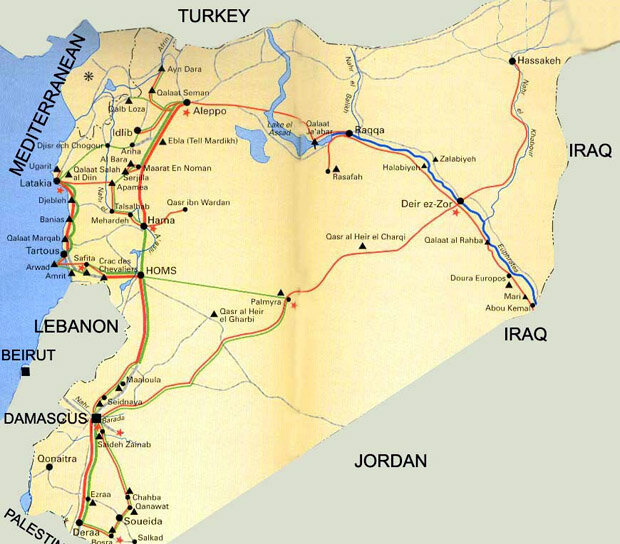
My route included: Damascus - Palmyra - Deir ez-Zor - Halabiye - Resafa - Aleppo - St. Simeon - The Dead Cities - Apamea -Crusader Castles - Damascus
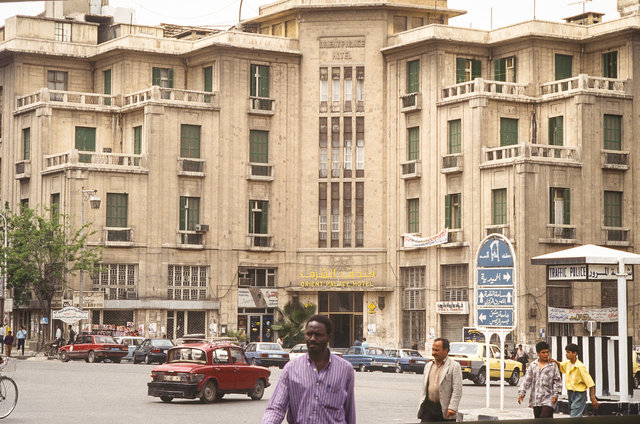
The Orient Palace Hotel opened its doors in 1932 during the French Mandate. It stands opposite the railway station and next to the entrance to the Old City. There were fancier hotels but this one had the right atmosphere.
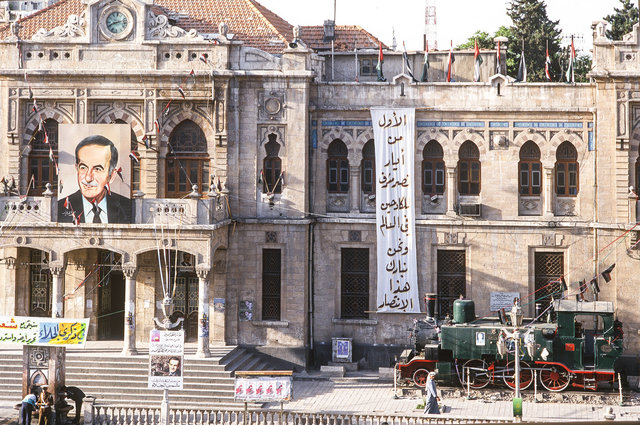
This is the view from my hotel room of the now defunct railway station opened in 1913. From this station, "Allah's Gate," the Hejaz railway, completed in 1908, ran from Damascus to Medina.

An engine like this once pulled carriages filled with pilgrims, and later Turkish troops to help quell the WWI revolt in Arabia.
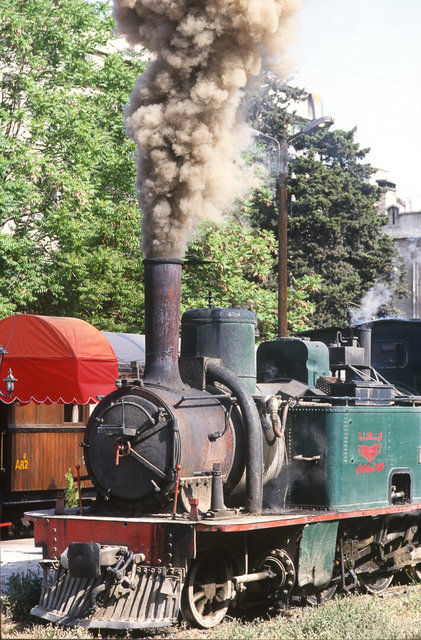
The 800-mile Hejaz railway was abandoned in 1920 after sabotage by Lawrence of Arabia and his Bedouin allies.

In the last years of Hafez al-Assad 30- year rule the cult of personality was in full swing. His picture appeared in every shop and public square. He died in 2000 and was succeeded by his son, Bashar. The ruling Baath Party, founded in 1947, espoused a modernizing pan-Arab ideal that was secular and socialist based on one-party rule.
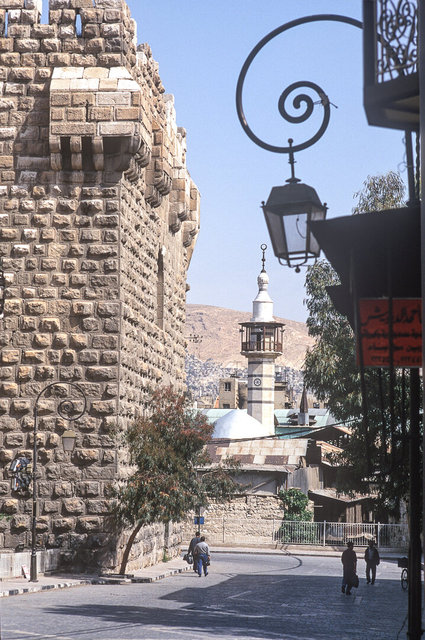
The late 13th C. citadel along the wall of the old city by the entrance to the Souq.
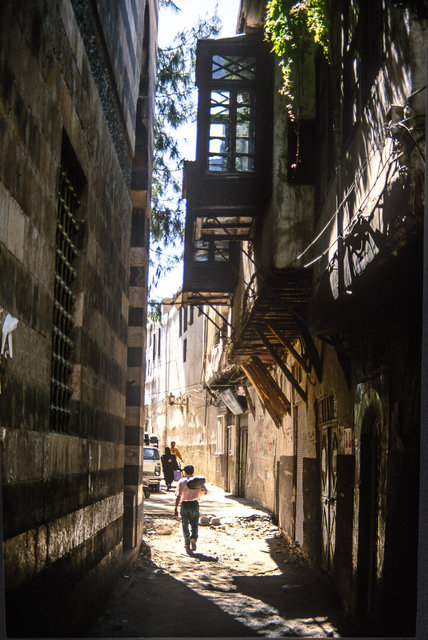
Narrow street in one of the oldest continuously inhabited cities in the world. The old city is surrounded by a three-mile mostly Roman wall enclosing 215 acres of houses, souks, mosques, churches and two remaining synagogues.
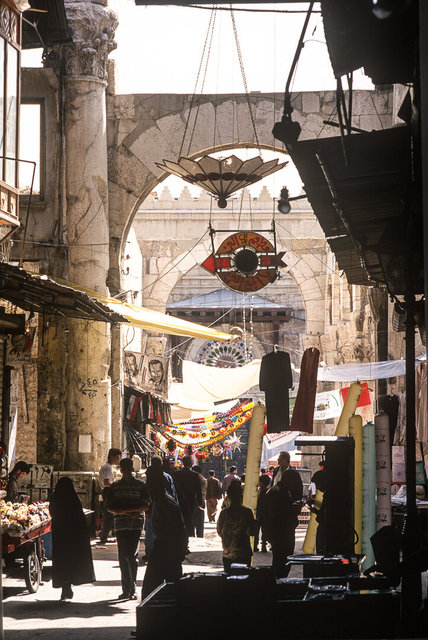
19th C. Al-Hamidiyah covered souq which terminates at what remains of the Roman triumphal arch marking the outer entrance to the 1st C. A.D. Temple of Jupiter.

A strolling tea seller in the Souq.

Rare Jewish antique dealer long established in the Souq. Most of the once flourishing Jewish community have left Syria due to Syrian hostility to Israel and loss of the Golan Heights in 1967.
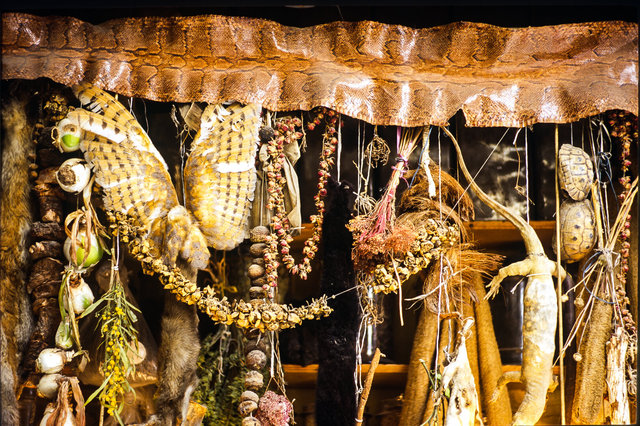
Ingredients used in potions and cures for sale in the Souq.

Men smoking hookahs at a sidewalk cafe near the Great Mosque. Many women in Damascus, including government workers wore western dress.
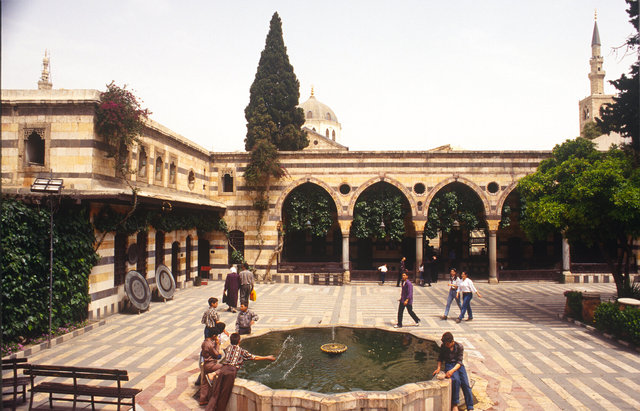
The Azem Palace, residence of the Ottoman governor of Damascus. Built in 1749. In the aughts many of these palaces attracted wealthy arabs from the Gulf and Saudi Arabia who restored much of their faded glory. The Old City has so far survived the war much neglected but relatively unscathed.
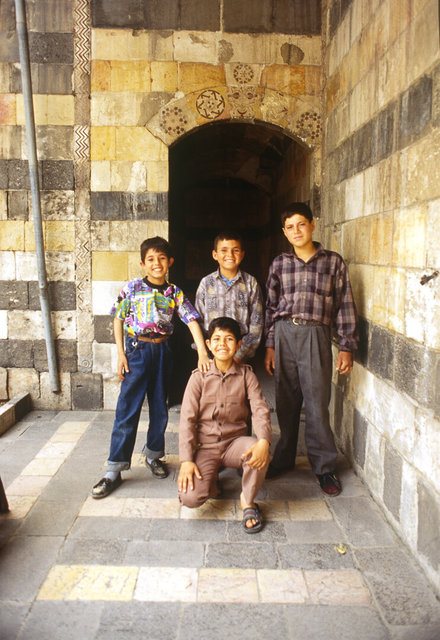
Before cell phones having your picture taken was still a novelty.
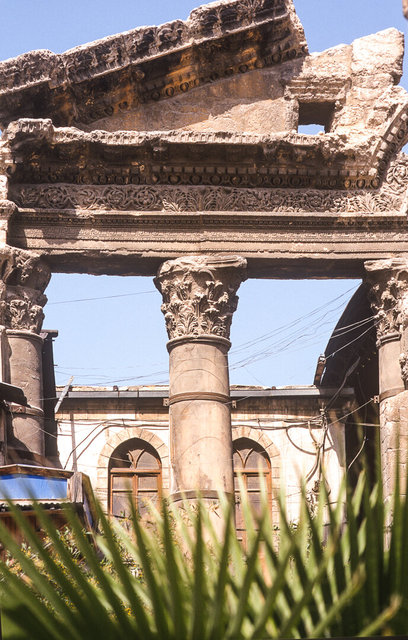
Fragment of the monumental entrance of the Roman Temple of Jupiter at the edge of the covered Souq. End of the 2nd C. A.D.
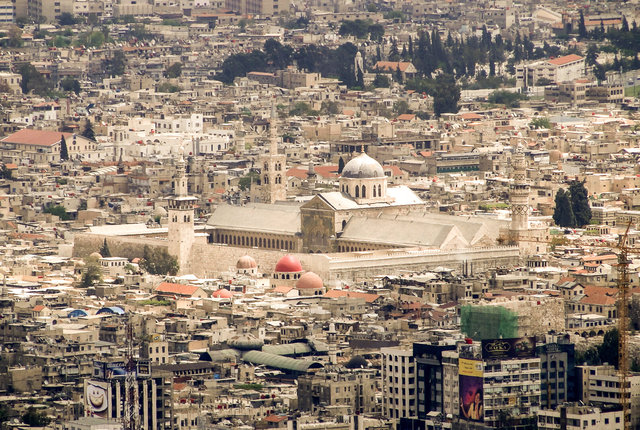
The Umayyad Mosque. Before being rebuilt as a mosque, this was a Christian cathedral dedicated to John the Baptist. Before that, it was a Roman temple dedicated to the cult of Jupiter. All were built on the site of what was once the most important temple in Syria dedicated to Semitic god of rain, Haddad. (Image courtesy Bernard Gagnon 2010.)

Roman wall enclosing the huge interior courtyard of the Umayyad Mosque.
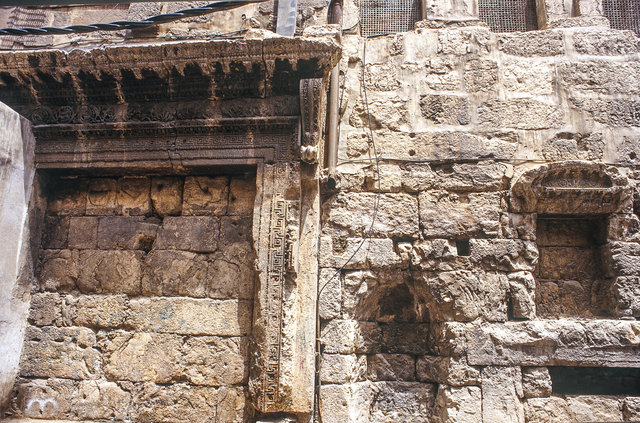
Blocked up pagan and Christian entrance in the Roman perimeter wall. Inscription over the door translates as "Your kingdom, Christ, is the kingdom of all eons and your rule is in all generations."
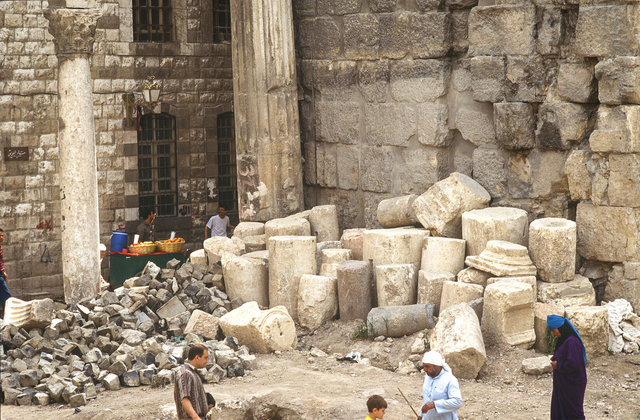
This is the approach to the Mosque entrance, past Roman remains. The same fruit seller is in the next slide.
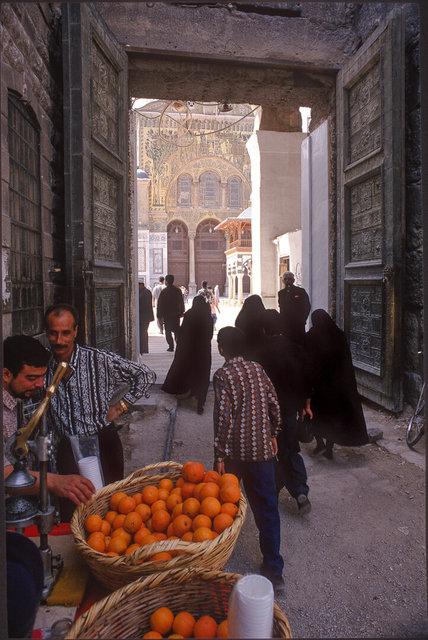
Main entrance to the Umayaad Mosque courtyard, flanked by bronze doors. This mosque is the fourth holiest site in Islam after Mecca, Medina and the Al-Aqsa Mosque in Jerusalem.
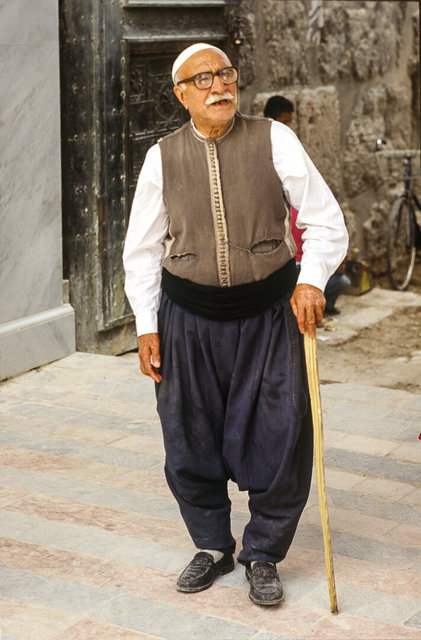
Guardian at the main Mosque entrance. Ladies are encouraged to borrow a black robe to cover western dress, but otherwise all are welcome to visit.
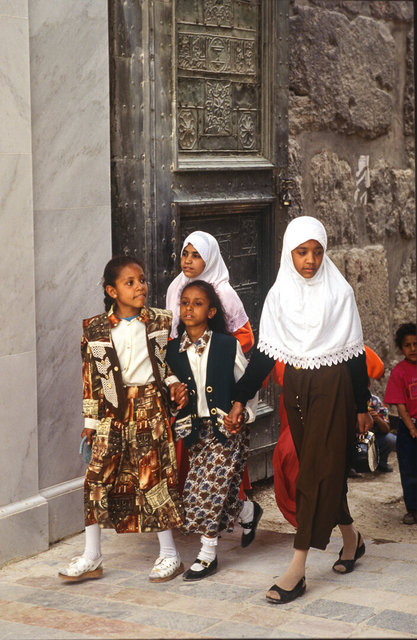
Visitors from all over the Muslim world are drawn to this famous site. Damascus was the capital of the Umayyad Caliphate which extended the Arab Conquest across North Africa and into Spain.
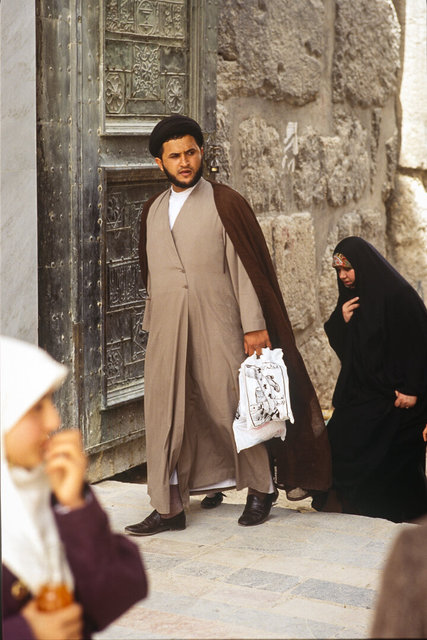
The Mosque is a major Shi'ite place of pilgrimage as Mohammed's martyred grandson is meant to be buried here.
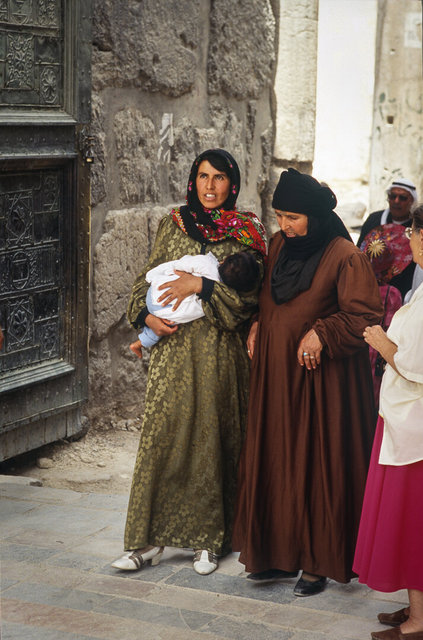
Bedouin women arrive to look up in wonder at the gleaming mosaics of the Transept of the Mosque.
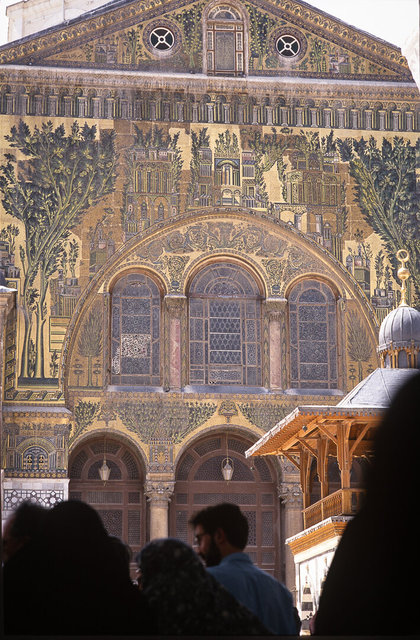
View through the entrance - at the mosaic decoration of the transept bisecting the prayer hall which runs along the whole of one side of the enclosure.
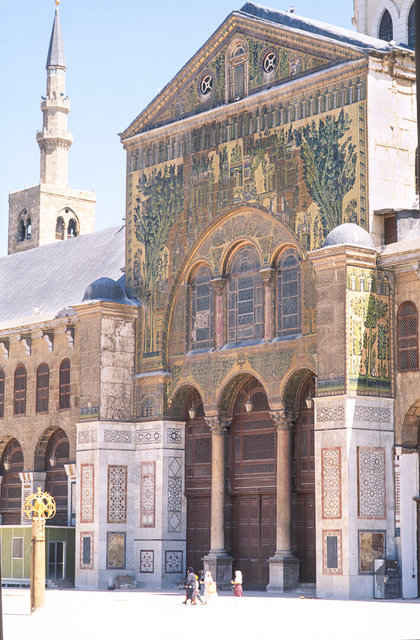
The Mosque transept across the marble courtyard surrounded by a two-story arcade.against walls dating back almost 2,000 years. The melodious call to prayer echoes over the city from one of these minarets five times a day.

The Mosque as it appeared in 1862 after years of neglect. Sacred places of worship have existed on this site since the 2nd millenium BC.
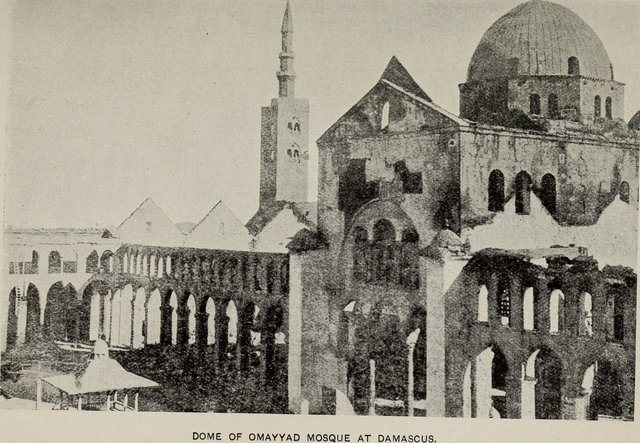
The fire of 1893 destroyed most of the old prayer hall. The Mosque has been added to and repaired numerous times with a history of invasions, Mongol sackings and earthquakes.

The Treasury is on the left. The 13th C. Minaret of Jesus is in the background. In Islam Jesus is the second most important prophet after Muhammad. Islamic teaching holds that Jesus will descend to this Mosque in the end times and together with the Madhi unite the world in peace.
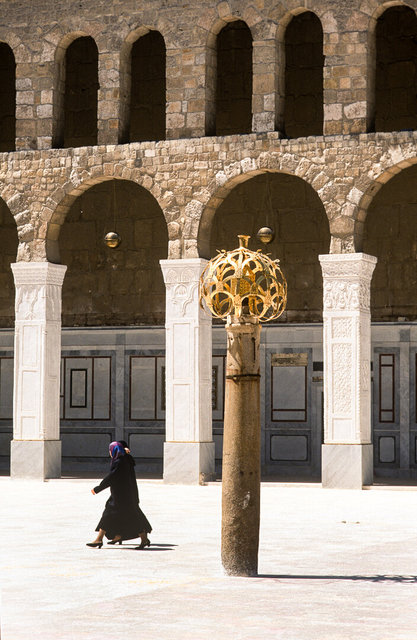
When the followers of Muhammad seized Damascus in 636 they left the Christian cathedral in place for the first 70 years of their rule. When they did repurpose this space they employed much of the language of classical and Byzantine architecture.
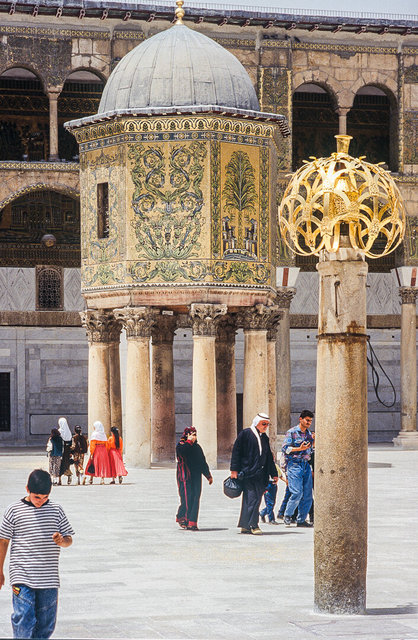
The Mosque's treasury raised on Roman Corinthian columns for security. The mosaics are thought to be 13th or 14th C. restorations. Most of the enormous volume of mosaics that once covered all the walls and arches have been lost,

Decorative lantern holder in the courtyard. The Mosque's mosaics have been many times restored over the centuries. The technique of mosaic is Greco-Roman and the artisans for this huge project are thought to have been imported from around the Byzantine world.
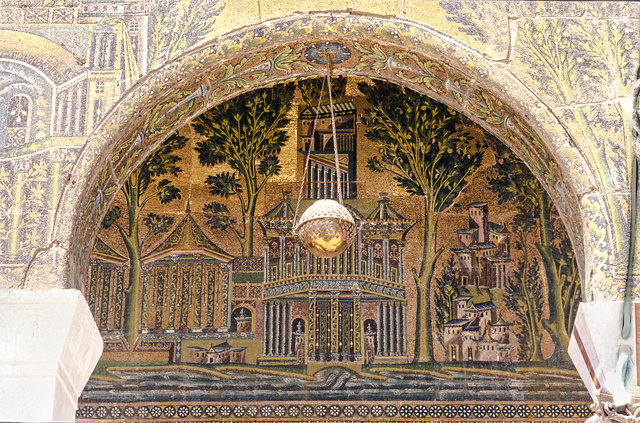
For generations of desert dwellers these mosaics fixed in two dimensions the Koranic vision of Paradise: " Such is the paradise promised to the righteous, streams run through it, its fruits never fail, it never lacks shade."

The gilded underside of the dome at the center of the prayer hall. The hall includes an elaborate shrine believed to contain the head of John the Baptist, sent here by Herod.

The interior of the prayer hall - surprisingly relaxed, with a family picnicking in one corner, birds flying by, a solitary figure in prayer in another corner. No chairs, carpets everywhere for strolling, sitting, or kneeling.
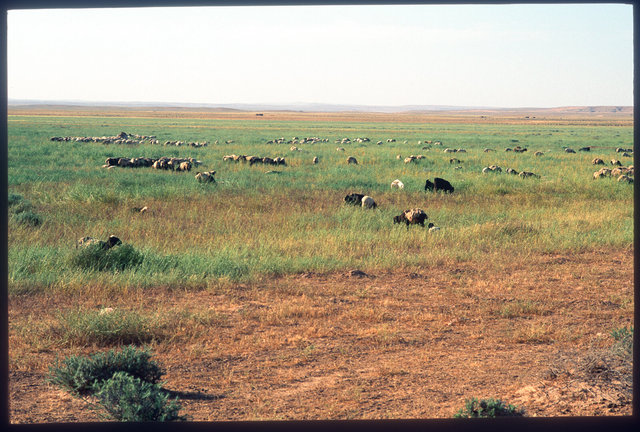
Sheep along the good two-lane highway running from Damascus east to the Euphrates. . It is a 3 1/2 hour drive to Palmyra and another 2 hours to Deir ez-Zor.
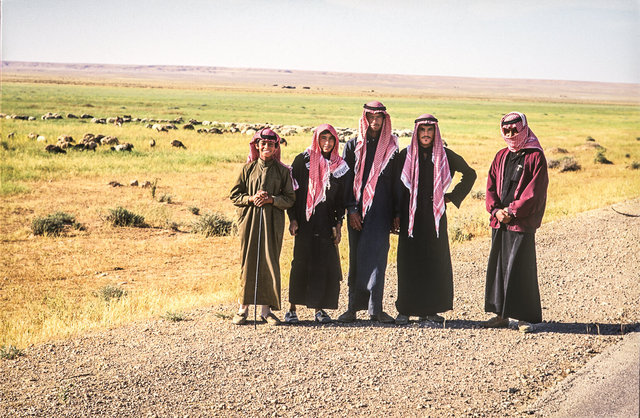
Bedouin sheep herders tending their flock by the highway heading east to Deir ez-Zor.

A cafe in Deir ez-Zor.
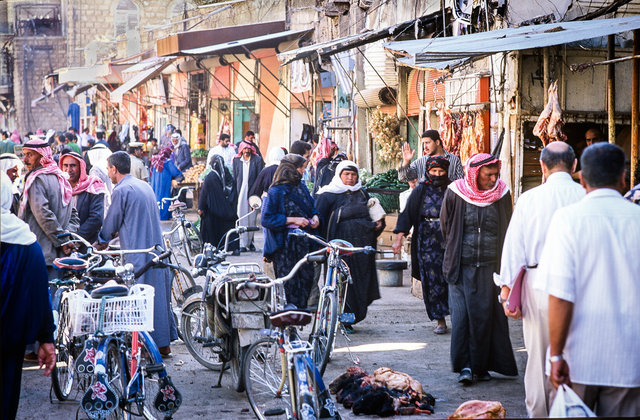
The meat market in Deir ez-Zor. Sheeps' heads lie on the pavement in the foreground.
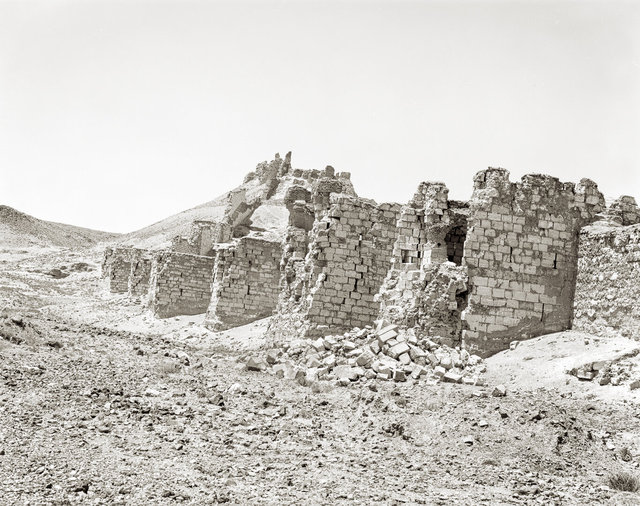
Halabiye guards a narrow passage in the Euphrates and is thought to date to the Assyrian Empire of 1,000 BC. Re-fortified by the Palmyrene Queen Zenobia, and then Rome, this garrison town became part of their defensive line with Persia. Massive gypsum walls up to 50' high enclose 30 acres topped by a citadel.

Looking toward the Euphrates from the Citadel. Towers along the wall are connected by covered passageways. Much of the remains on view today including two churches date from the time of the Byzantine emperor Justinian.

The 3-story Praetorium built by Justinian to house garrison troops in the mid-6th C The town was largely abandoned by the 7th C..

One hour into the desert west of the Euphrates stands the deserted Byzantine town of Resafa. Originally an Assyrian encampment, it stood on the caravan route to Palmyra. Fortified by Rome as part of its defensive line, it became an important pilgrimage destination after the martyrdom here of a Roman soldier in the early 4th C.
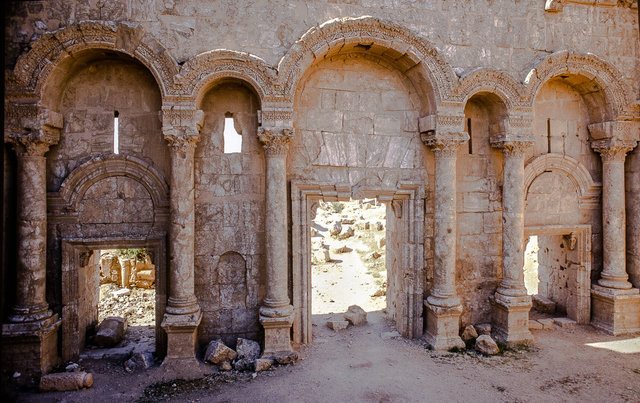
The town's walls are still largely intact although more recently damaged by ISIS. This elaborate North Gate dates from Justinian's extensive building program.
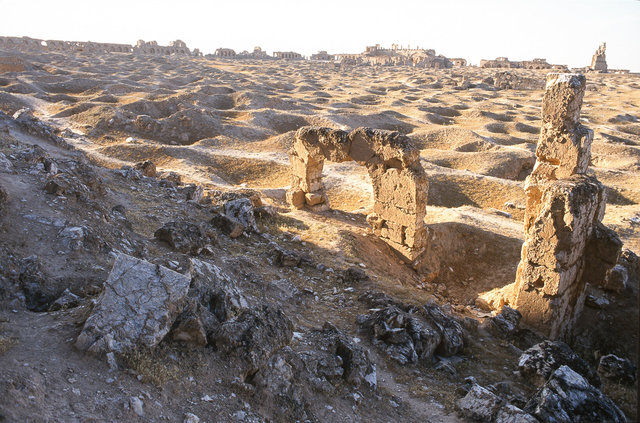
The view from the perimeter wall enclosing 37 acres. The pockmarked ground is the result of blowing sand and excavations.
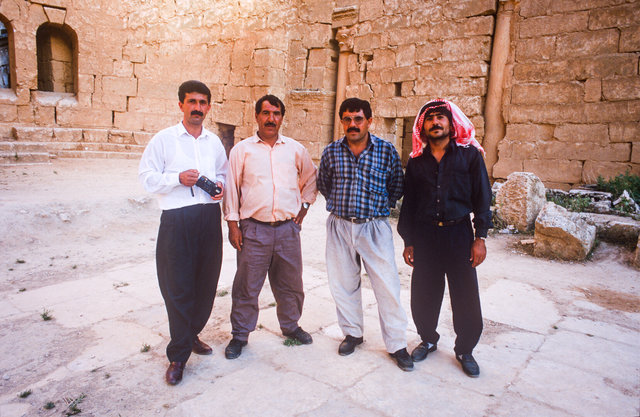
I had planned to spend the night in the ruins. These school teachers, the only other people I saw, pointed to my tent and encouraged me to stay at their school. Asked why not stay in Resafa, they warned me to look out for desert dogs.
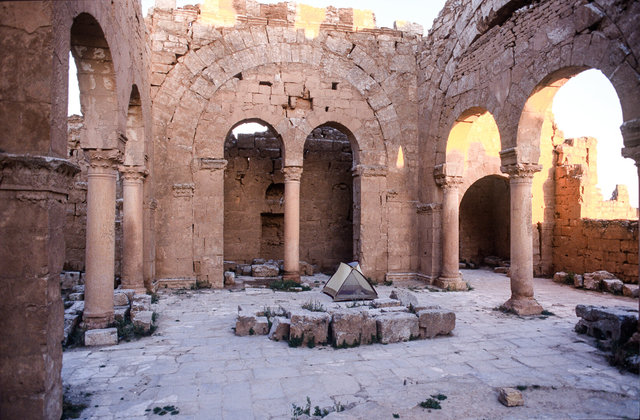
My tent in the Basilica of St Sergius. After strolling alone in the still ruins as night fell, I tried to sleep - while imagining dogs, like the desert fox I'd seen emerge from the Byzantine drains nibbling at my toes.
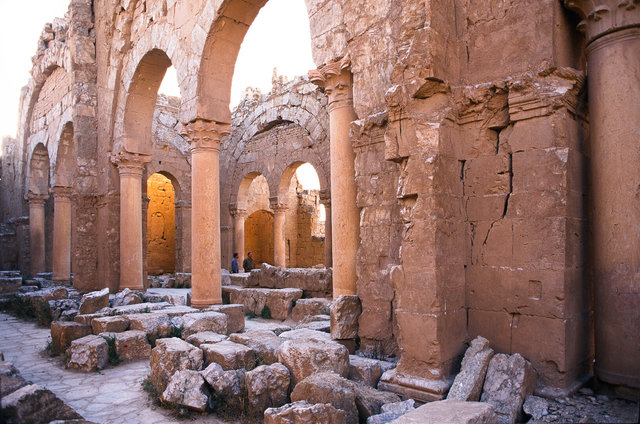
This basilica is typical of early Christian church architecture which adapted the Roman form of public building - a rectangle enclosing a central and two flanking aisles, with a tile roof at two levels to admit light through clearstory windows.
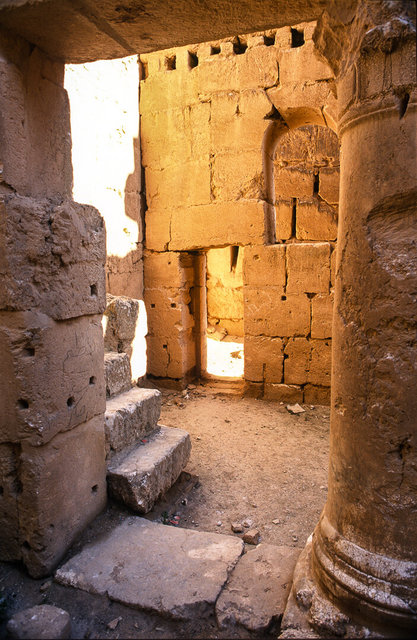
As the cult of St Sergius grew in the early 5th C. Resafa was renamed Sergiopolis in 425, when it was the second most popular Christian pilgrimage destination after Jerusalem. Churches dedicated to St Sergius and his fellow officer Bacchus were later founded in Constantinople and Rome.

In the middle of the night I was awakened by a bright light shining on my tent which turned out to be the newly-risen moon bathing the ruins in an eyrie silvery light.
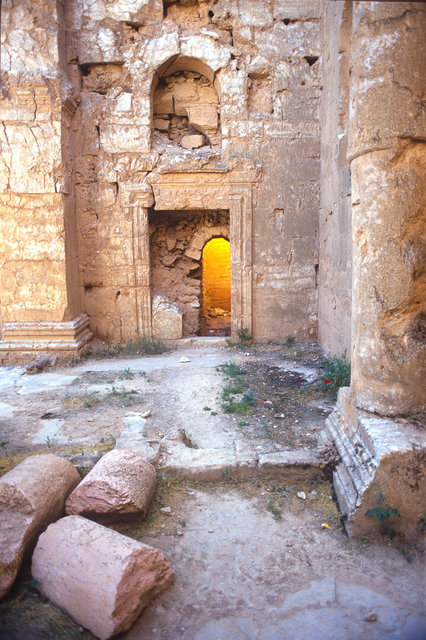
Sergius was a high ranking Roman officer reputed to have been beheaded and buried in Resafa in 305 A.D. A secret Christian, he and a fellow officer were exposed when they refused to sacrifice to Jupiter.
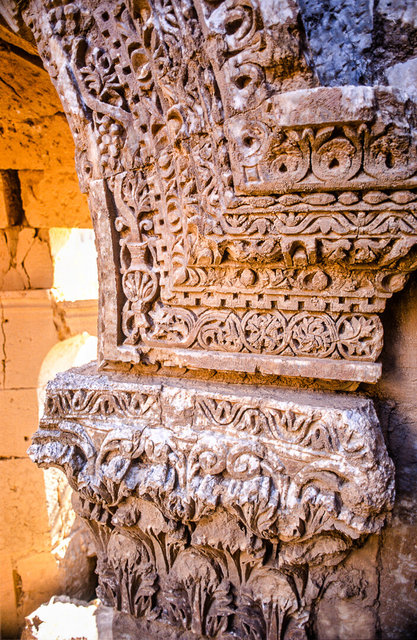
Byzantine decoration revealing Northern Syrian and Mesopotamian influences. Interior church decoration included elaborate mosaics now lost. German archeologists unearthed ritual silver vessels including a chalice used in the Eucharist 1500 years ago.

The original 6th C. design had daringly wide lateral arches separating the nave from the side aisles. 20 years later the arches were partly filled in with two new arches and supporting pillars to better support the weight of the roof, It would be many centuries before Byzantine and European engineers worked out how to support such wide openings with piers and buttresses.
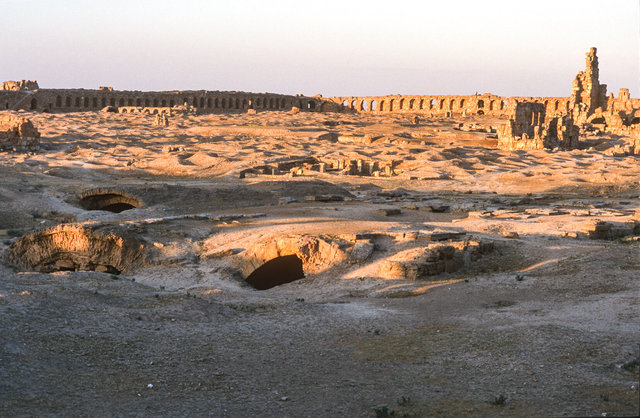
Cistern openings. Resafe had no spring or running water, so it depended on three huge underground cisterns for storage. Outside the walls a dam blocked a local wadi and channeled winter floodwaters to the cisterns. The system was built in the early 6th C.
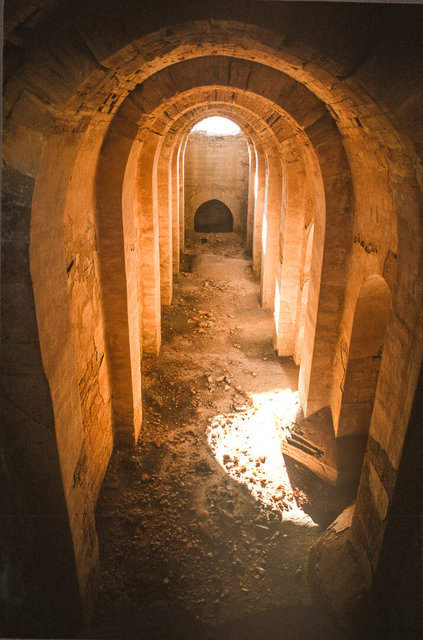
Peering into the largest of the cisterns, 180' long, 60' wide and 40' deep. More of Justinian's work.
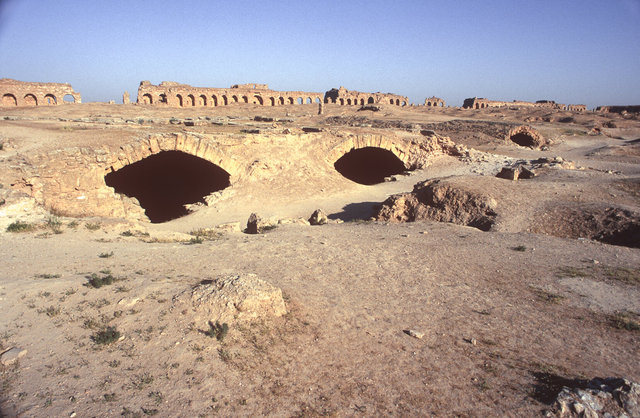
The following morning provided a clear view of the surrounding defensive walls.

The Centralized Church - This is a Christian martyrium built to shelter the grave of the martyr, St Sergius. Martyria were common after the early 4th century, when Constantine became the first Roman emperor to declare religious tolerance for Christianity. Their circular orientation was based on the mausolea of imperial Rome.
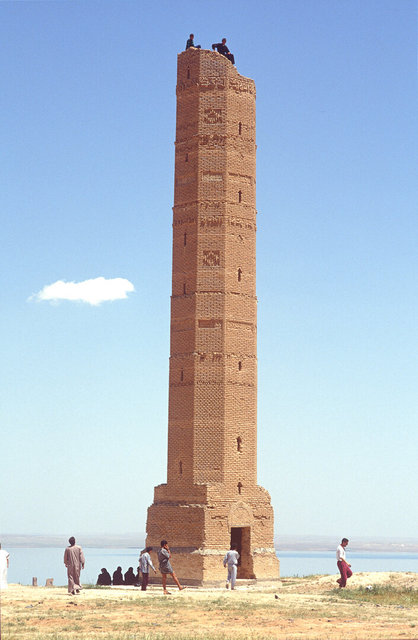
13th C. brick-built octagonal minaret moved 2km to higher ground in the 1970s to avoid flooding of Lake Assad behind the new Euphrates dam.
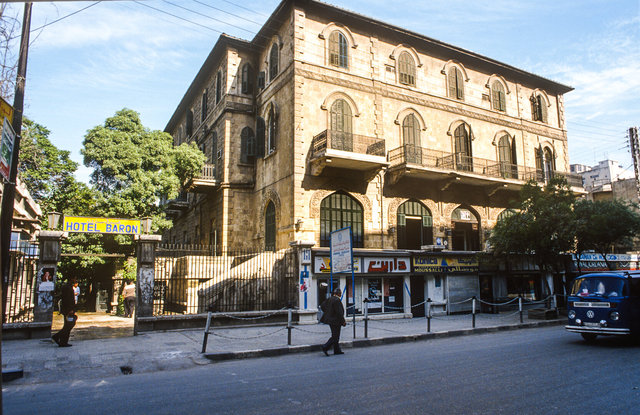
My home in Aleppo, the storied Baron Hotel. Built by two Armenian brothers starting in 1907. Lawrence of Arabia's unpaid bar bill hung in the bar. Agatha Christie began her novel Murder on the Orient Express in room 203. In 1920 King Faisal declared Syria's independence from its balcony.
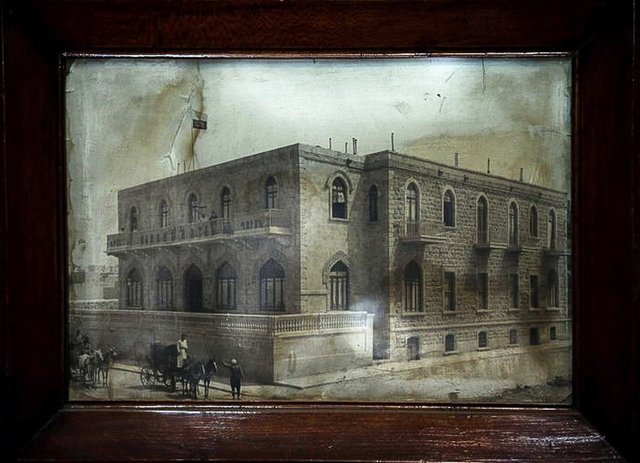
Two floors of Baron's were complete by 2011 with the third added in 1940. The hotel was built for Europeans who found the caravanserai lacking in privacy.
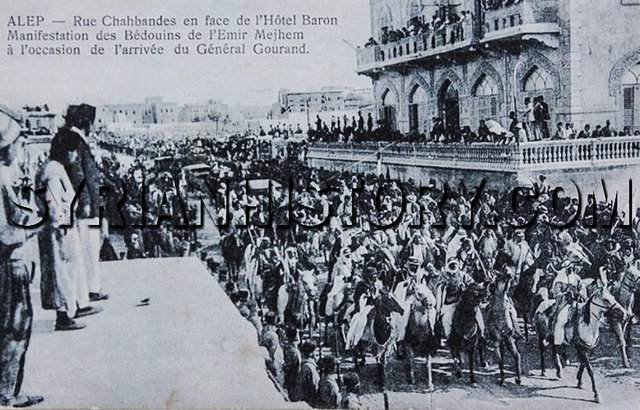
The terrace and balconies of Baron's provide a good view of the parade of Bedouin warriors in honor of the arrival of General Gourand in 1920. After WWI France and Britain took parts of the Ottoman Empire for themselves. Gourand replaced Faisal's briefly independent Syria with a new French Mandate over Syria and Lebanon.
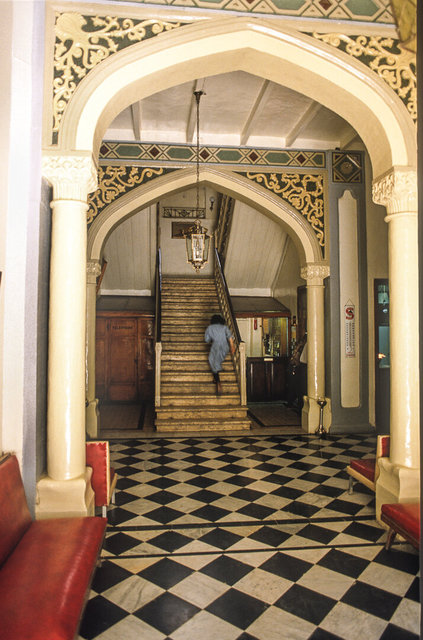
The entrance lobby of the Hotel Baron. The building is reported to have sustained minor damage in spite of being close to the front lines of the civil war.
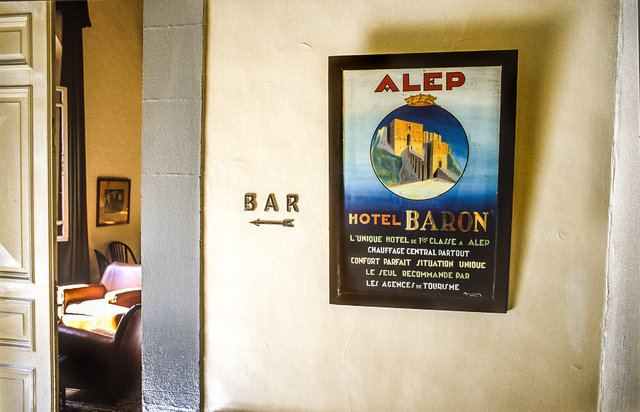
The glass poster reads -"A unique hotel of the 1st class in Aleppo - central heating throughout - perfect comfort - a unique location - the only hotel recommended by tourist agencies.
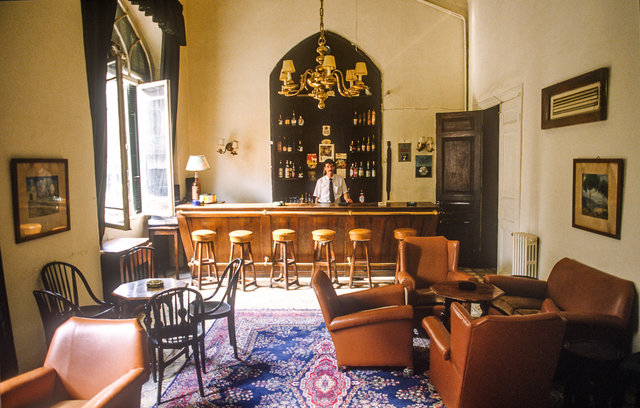
The bar, where before 1914 English agents posing as archeologists spied on German generals entertaining their Ottoman allies. On my visit, a half dozen plump Russian trader women sat with bales of jeans at the bar along with two German engineers and several Syrian army officers.
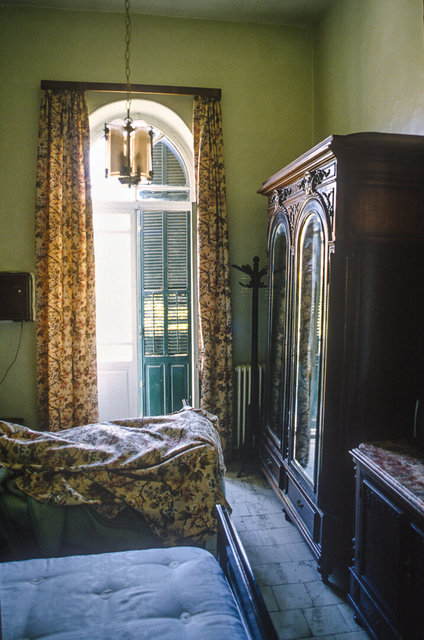
My room was cooled, barely, by a rattling air conditioner. The mattress was certainly less comfortable than when T.E. Lawrence last slept in it. But who could resist the history.
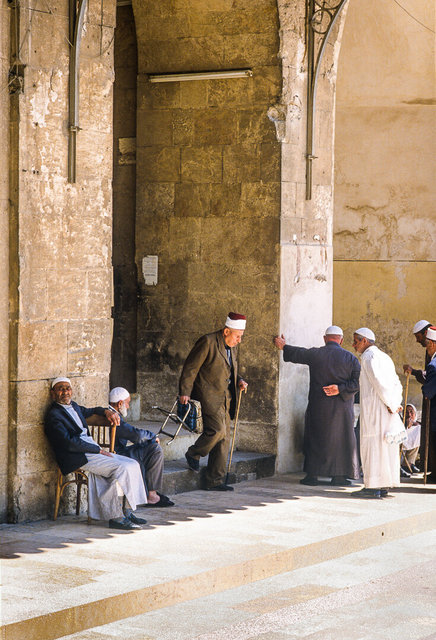
The Great Mosque in the old city was completed 10 years after the Umayyad Mosque in Damascus in 717. It was built on the site of the Hellenistic agora in the garden of the Byzantine Cathedral of Saint Helena. The atmosphere is relaxed in the shaded arcade where old men gather and gossip.
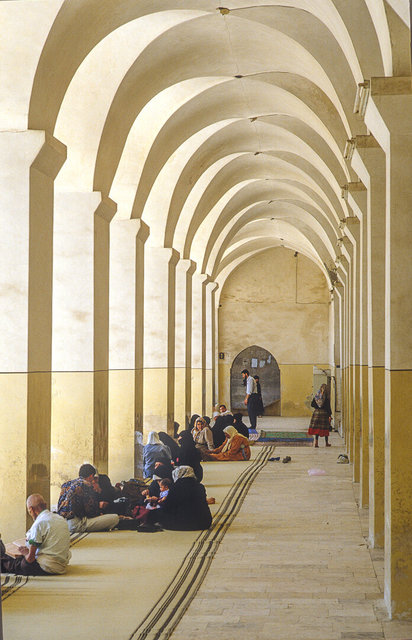
Another view of the Mosque arcade as it appeared in 1996, a peaceful retreat for individuals and families from the nearby crush of the Souq.
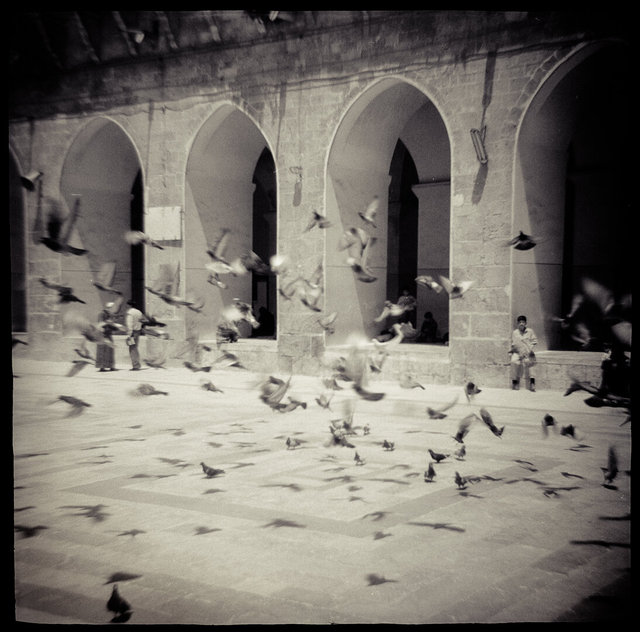
Courtyard of the Great Mosque taken with a toy camera and 120 roll film.
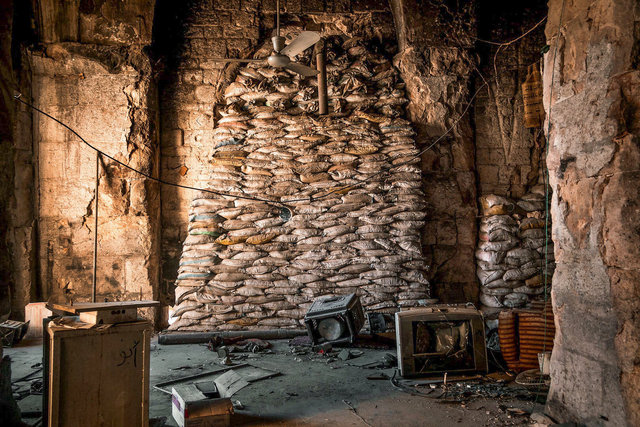
Inside the Great Mosque of Aleppo in early 2017. The city was recaptured with the help of Russian airstrikes. - (credit Sebastián Liste/Noor Images, for The New York Times.)
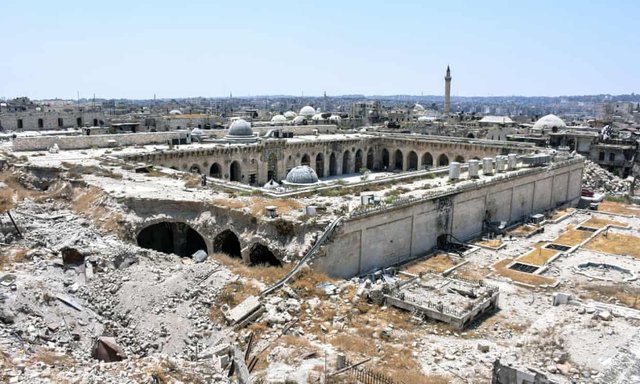
Ruins of the Great Mosque in Aleppo as it appeared in 2017. The minaret built in 1090 collapsed into thousands of fragments during shelling, and is now being painstakingly reassembled. (AFP/Getty Images)
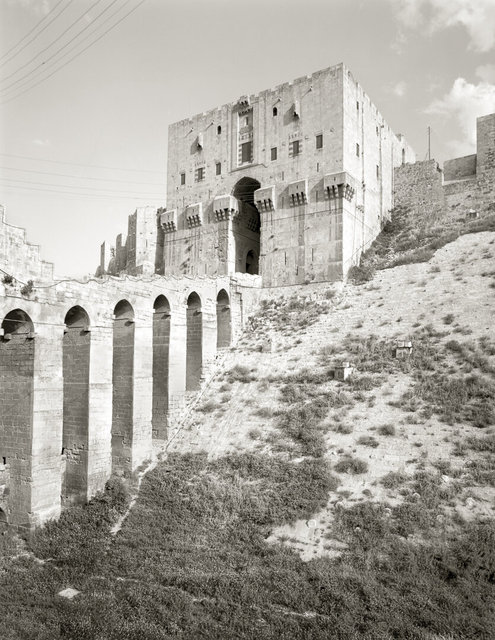
The Citadel of Aleppo defends an acropolis that dates back 4,000 years. It is one of the oldest and largest castles in the world and dominates the city below. It has been occupied by many civilizations over the millenia including the Hittites, Assyrians, Babylonians, Persians, Armenians, Greeks, Romans, Byzantines, Ayyubids, Mamluks and Ottomans. The arched bridge dates from the 16th C.
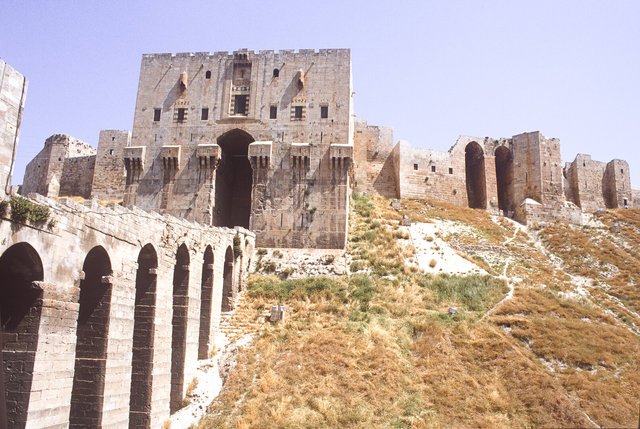
The Citadel is encircled by a steep glacis of smooth stone that makes scaling difficult and leaves attackers exposed. Much of the structure we see today is Muslim work dating from the 12th and early 13th C. restored following the Mongol sack of 1400, and more recently in the 20th C. The Citadel has suffered significant damage in the current civil war.
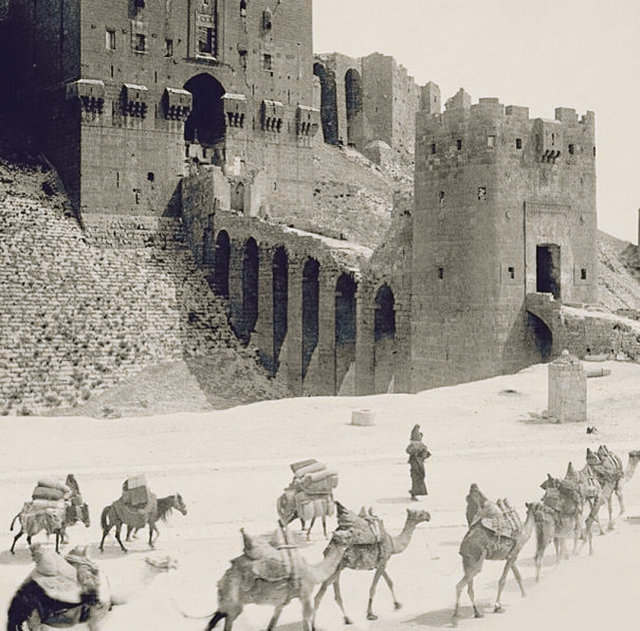
The Citadel in the mid-19th C.
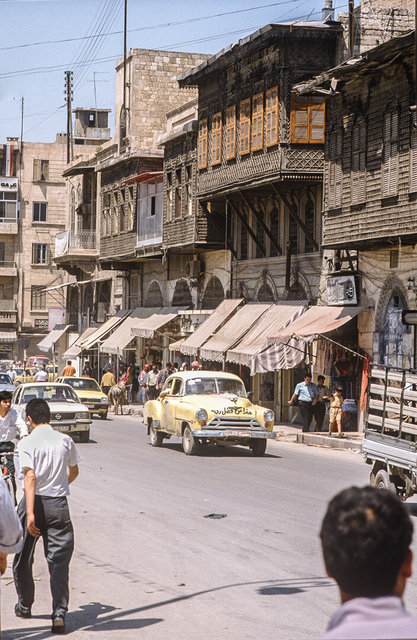
By the entrance to the ancient Aleppo Souqs.
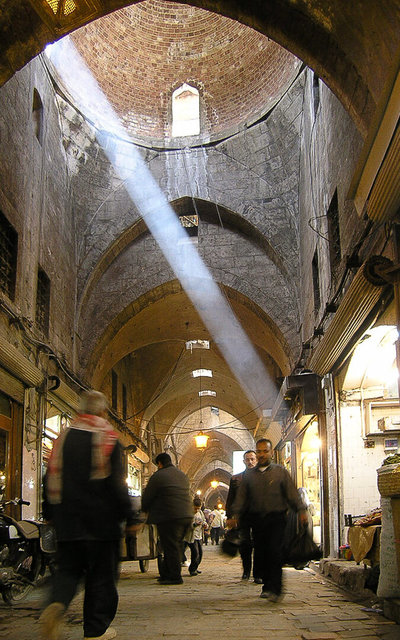
Inside the walls of the old city is the Souq al-Madina. With its long and narrow alleys, this is the largest covered market in the world, with an approximate length of 8 miles, lined by 1,000 small shops. (photo courtesy of Seier+Seier).

The Souq alleyways connect to other civic structures such as this medieval asylum built in 1354, where violent lunatics were chained.

The Hammam al-Nahhasin, entered from the Souq, is one of the oldest and largest public baths in Aleppo, It dates from the 12th C. It has been rebulit many times since, most recently in 2021 following heavy civil war damage.
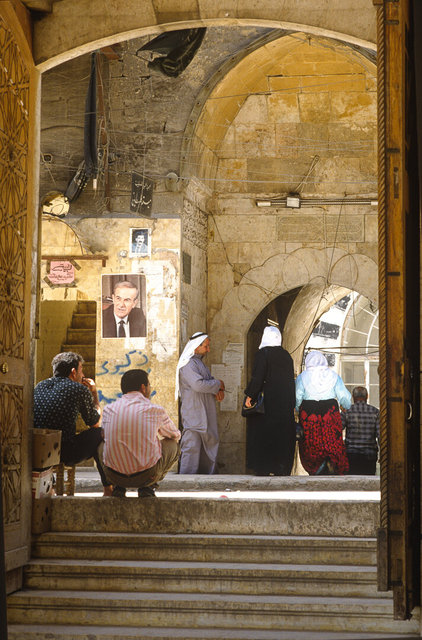
Most of the al-Medina souqs date from the 14th C. They were a world unto themselves. Traders from distant lands could stay in caravanserai in the souq. European consuls established their own khans in the maze.
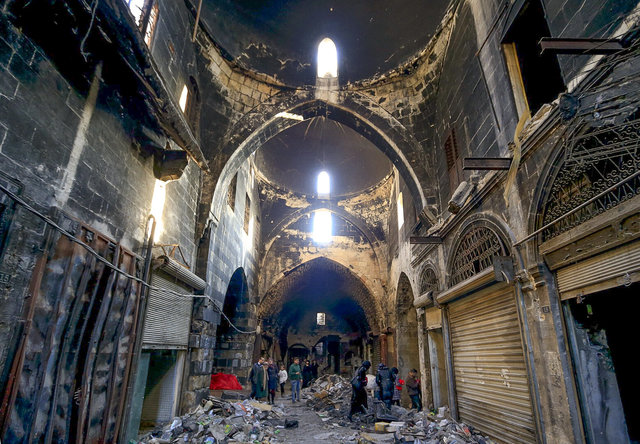
In addition to 31,000 dead, years of shelling, airstrikes and barrel bombs, left much of the city in ruins including severe damage to the Souk, the Great Mosque and the Citadel. Restoration work has begun but will take decades to complete. (AP Photo/Hassan Ammar.)
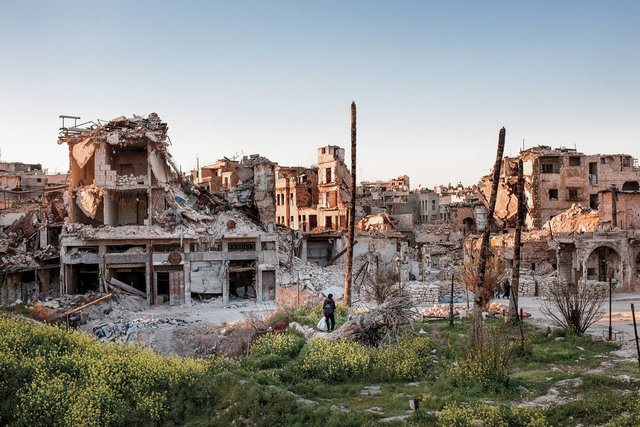
Al-Hatab Square in Aleppo’s Old City after the City's recapture by the Government in late 2016. Almost 36,000 buildings were damaged or destroyed in four years of fighting.- Photo by Sebastián Liste/Noor Images, for The New York Times.
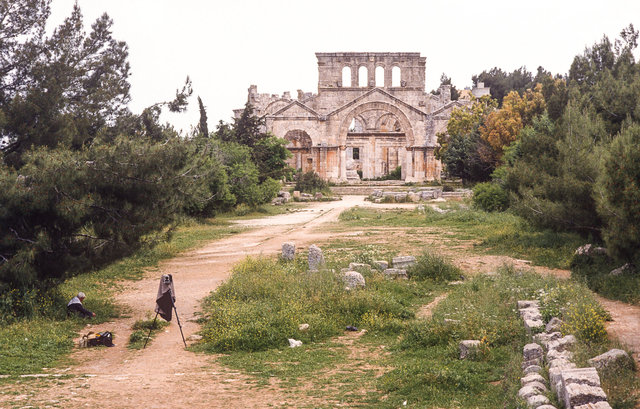
In the hills northwest of Aleppo stands the ruin of the Christian pilgrimage center of St. Simeon Stylites. Simeon was born in nearby Antioch around 390 A.D. A devout ascetic, he moved from a cave to a platform atop a pillar here, where he lived for several decades. This strange new form of asceticism attracted the curious and faithful from many miles around. My view camera is in the foreground.
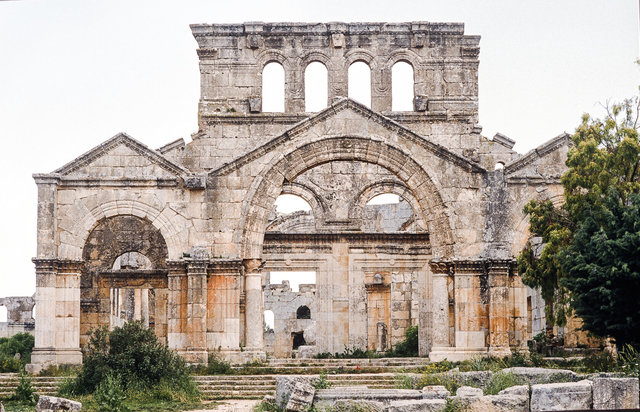
Simeon set on his pillar to put some distance between his private devotions and the many visitors who came to hear him preach. He died there in 459 A.D. having won the admiration of the Church hierarchy all the way to Constantinople. This is the entrance to the great cruciform church erected around the base of his pillar not long after his death.
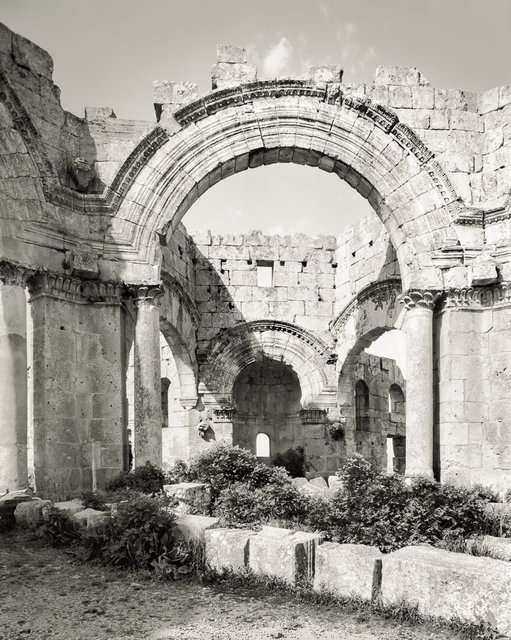
One of the eight sides of the courtyard with the base of Simeon's pillar as the central point of focus. The four radiating basilicas come together at this point forming a cruciform design. Simeon's body was carried away to Constantinople, so this church is a shrine in his memory built with Imperial patronage.

An upside down Chrisomon, combining the Chi-Ro, symbolizing Christ, and the Alpha and Omega - first and last letters of the Greek alphabet, and the title "Christ and God" in the Book of Revelation.
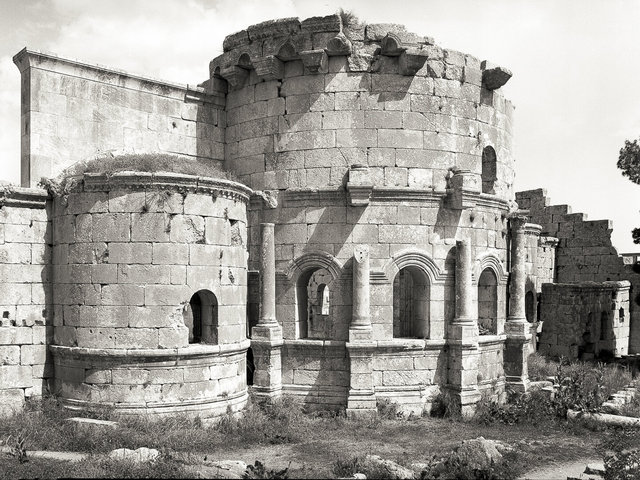
Outside wall of the of the eastern basilica of the cruciform church with decorative columns and finally detailed window surrounds.
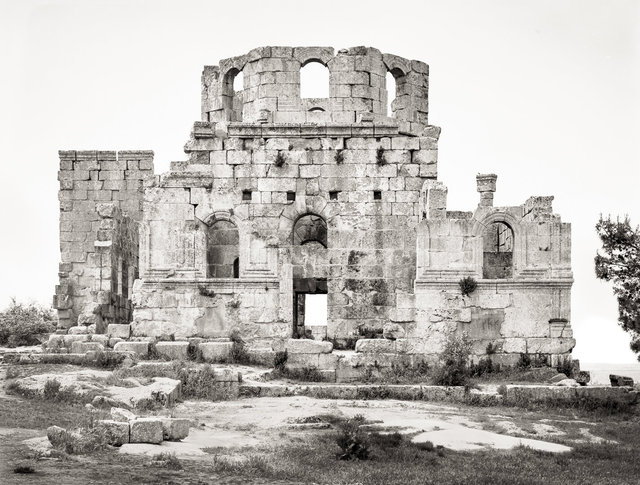
The Baptistry of around 490 A.D. is an essential part of the pilgrimage complex. The octagonal drum once had a roof shaped like a cone. The interior layout was designed to facilitate the mass baptism of converts. This Christian community was sacked by an Egyptian army in the 11th C. and abandoned.
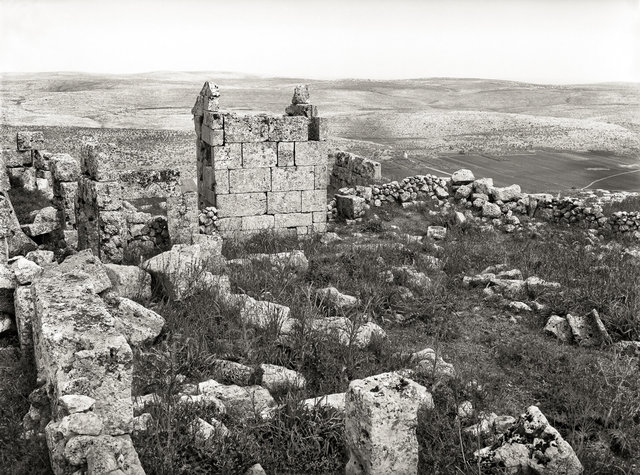
The Dead Cities are a group of 40 villages in northwest Syria between Aleppo and Idlib. Most of the villages, which date from the 1st to 7th centuries, were abandoned between the 8th and 10th centuries. The settlements feature the remains of dwellings, pagan temples, churches, cisterns, and bathhouses.
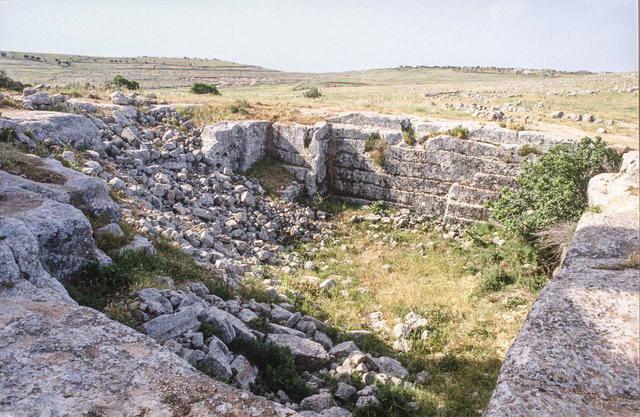
The Dead Cities are situated in an elevated area of limestone known as Limestone Massif between Aleppo and the sea. These ancient settlements cover an area 20 miles wide and 90 miles long. Building materials were easily mined from quarries such as this.

It is thought these villages prospered during late Antiquity when their olive groves found a ready market in nearby Antioch. After the Muslim conquest trade with Anatolia was reduced and their inhabitants gradually migrated to more prosperous cities..
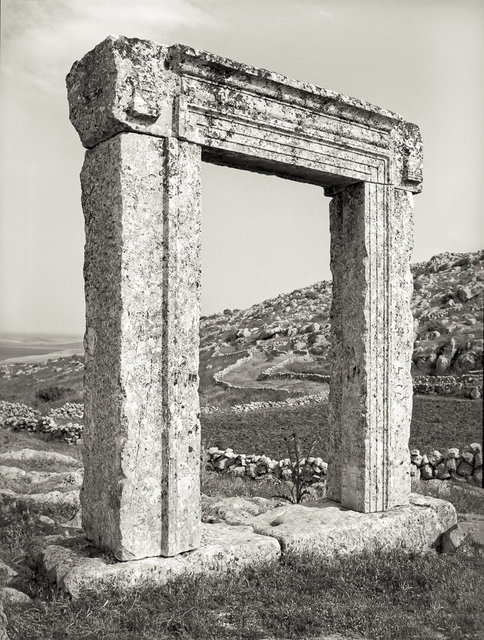
Access to the sea is no longer possible as these villages are now bounded on the west by a hostile border with Turkey. Some of these villages in Idlib Province have provided shelter to civil war refugees.
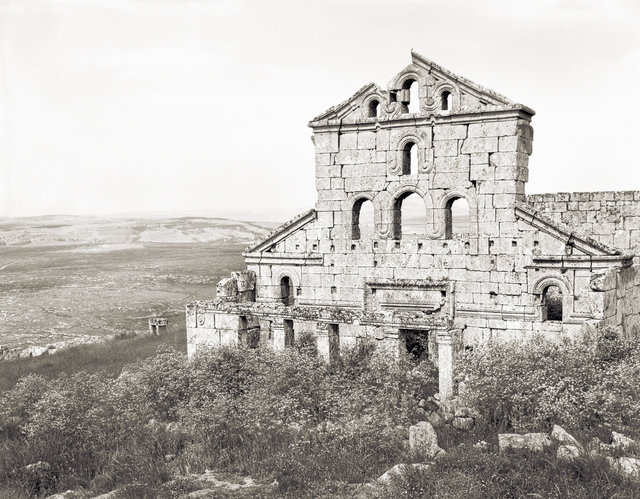
The abandoned village of Baqirha. This Byzantine Church dates from 546 AD. It has the typical three-aisle basilica plan. Located on the slope of the Syrian limestone hills, it looks down on the Turkish plain below.
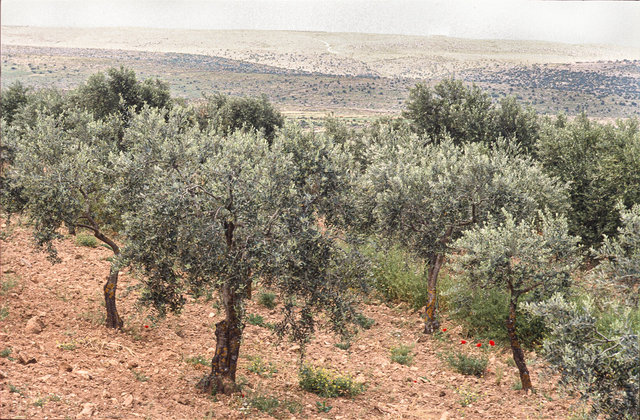
One of the few olive groves still tended in the hills west of Aleppo.

Apamea is the ruin of a Greek-Roman city founded by one of Alexander the Great's generals, Seleucus Nicator (358 –281 B.C.) His Seleucid Empire, one of the major powers of the Hellenistic world, controlled most of Asia Minor, Syria, Mesopotamia, and the Iranian Plateau. In 64 B.C. Apamea fell to Pompey and was annexed to the Roman empire.
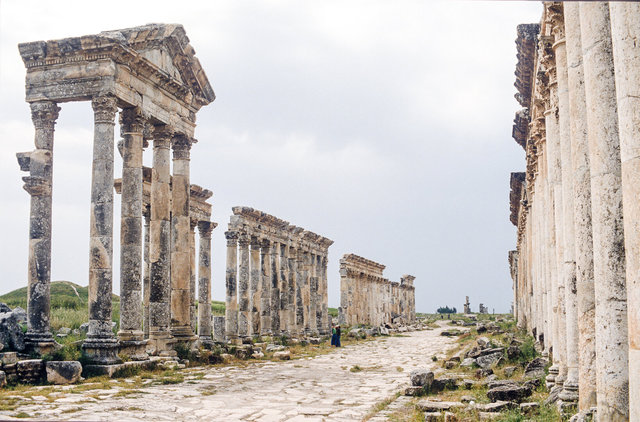
In the boom years of the 2nd C. A.D the Romans made this a large and prosperous town with a population of more than 130,000. Most of the remains seen today are Roman.
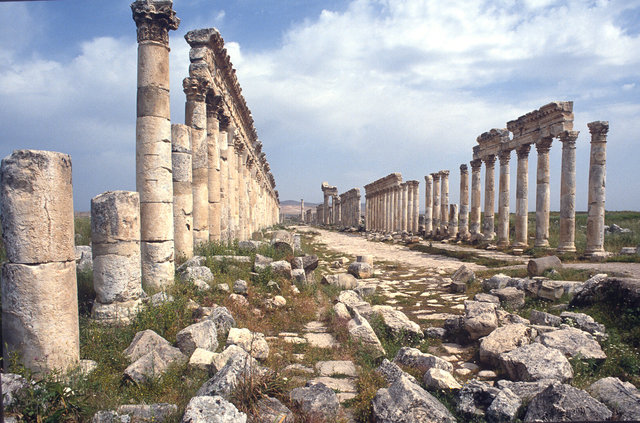
The colonnaded porticos were paved with mosaics along their whole length being lined with stalls and shaded arcades.
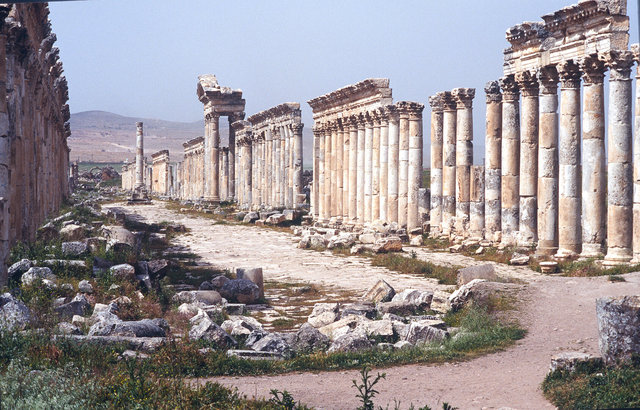
The 1.2 mile colonnade is one of the longest in the Roman world. This avenue fronted villas, temples, baths and the agora. The ruined theater once held up to 20,000.
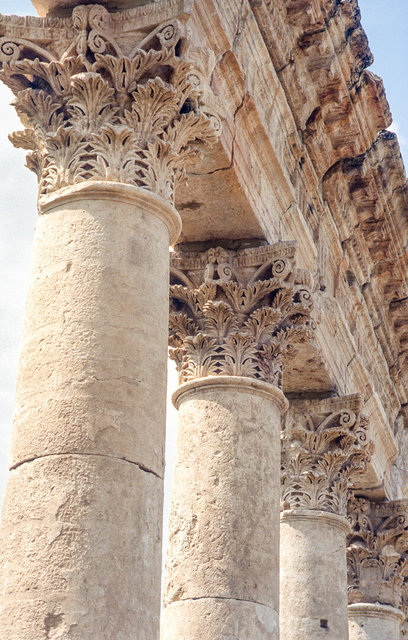
Apamea has been excavated since 1934 by Belgian teams who have carried out one of the most thorough investigations of any site in Syria. Much of the fruits of their labors including a reconstruction of the Colonades can be seen in the Art and Hisory Museum in Brussls. During the civil war there has been damage to the site by many treasure hunters.
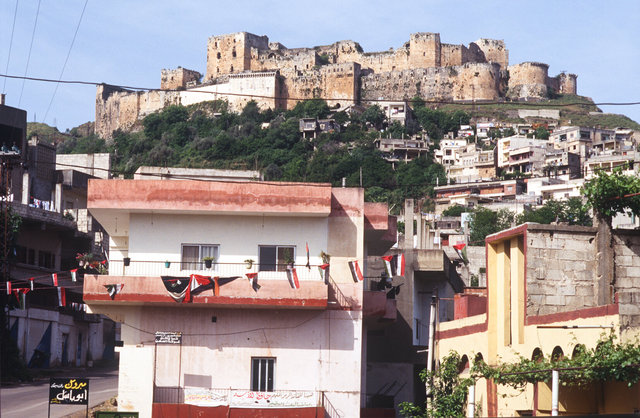
Masyaf Castle in town of Masyaf 40km west of Hama. This is a Byzantine and Shia castle with later additions by Mamluks and Ottomans.This stronghold was the capital of the Shia Ismaili emirate in Syria for 130 years from 1141 A.D. This sect, also known as the Assassins, defended their interests by infiltrating enemy courts by stealth and dispatching their rivals with daggers.
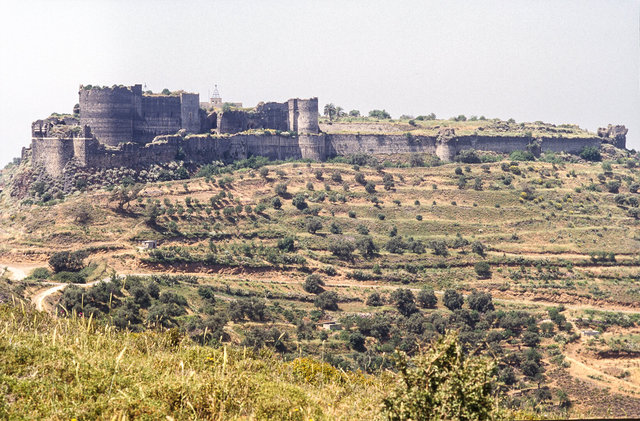
Margat or Marqab Castle, first fortified by Muslims in 1062. It overlooks the Mediterranean above the road between Tripoli and Latakia. The first Crusade took the castle from the Byzantines in 1186. It then came under the control of the Knights Hospitallers. This is one of over 50 Crusader castles in the Levant.
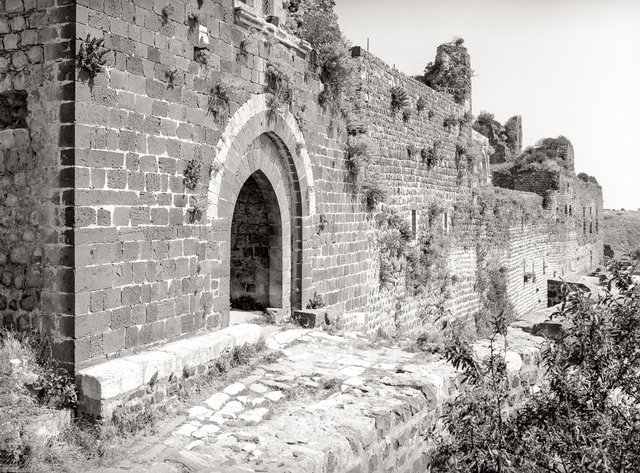
Under the Knights, Margat prospered with taxes on pilgrims and travelers passing nearby. In 1285 it finally fell to Mamluke attackers. The castle served as the residence of an Ottoman district Governor until 1884.
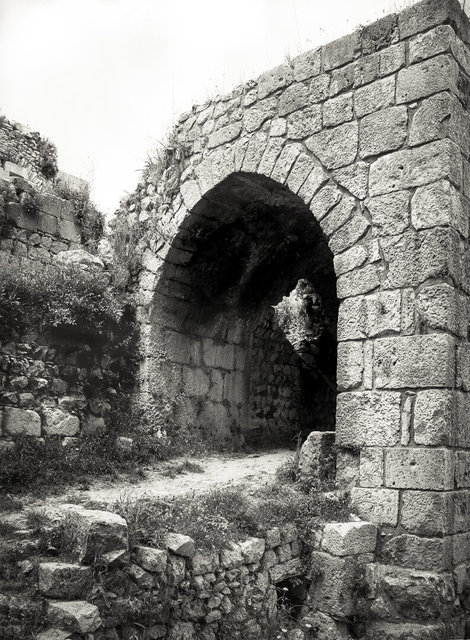
Entrance to the Crusader castle of Saone (Sayhun) in the hills east of Latakia. A Phoenician fort in the first millenium B.C. it was fortified by the Byzantines after 975. The Frankish family of Robert of Saone largely rebuilt the fortress between 1100 and 1188 as a feudal endowment from the crusader state of Antioch.

The ditch on the North side of the outcrop on which the Saone fortress was built. This 90' deep ditch is believed to have been cut from the living rock by the Byzantines. The pinnacle would have supported a wooden drawbridge.
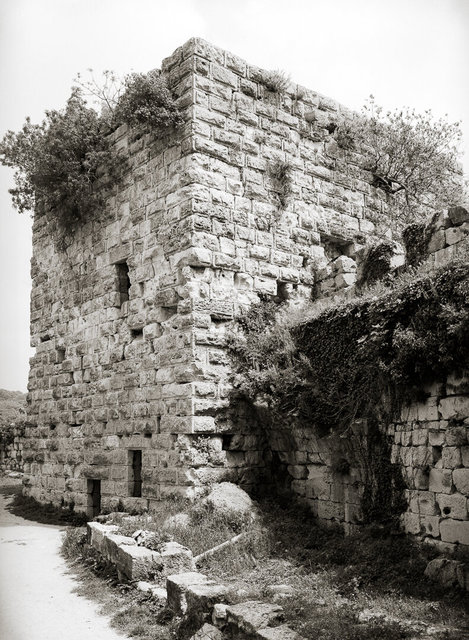
This fortified tower by the entrance to the castle was built by Crusaders. In 1188 Saone fell to the forces of Saladin after a three-day siege. The castle remained prosperous under the Mamluks until at least the late 14th century.
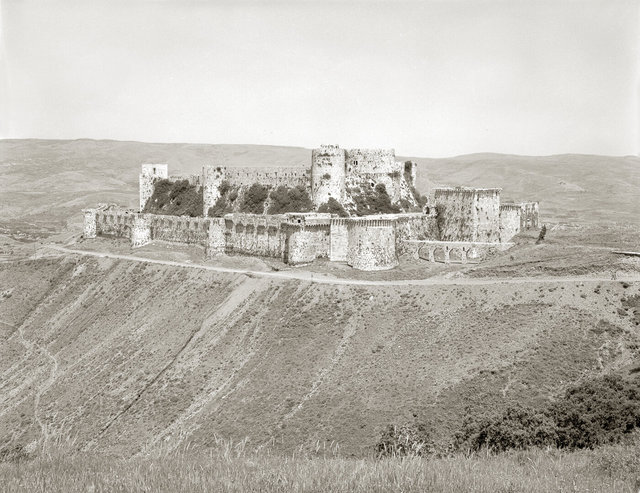
Krak des Chevaliers. One of the most impressive medieval castles in the world. First fortified in the 11th C. by the Muslim ruler of Aleppo. It dominated the road from Homs to the coast. In 1110 the First Crusade took control of the site, and in 1142 gave it to the Knights Hospitaller who would occupy it for the next 130 years.
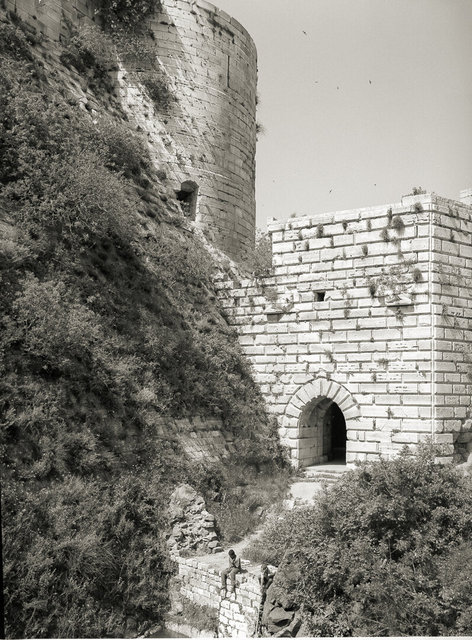
The Knights undertook an elaborate rebuilding program completed in the early 13th C. resulting in the massive form we see today. The castle served as an administrative center for the Crusader state of Tripoli and as a garrison for 2,000 troops guarding the Homs Gap.
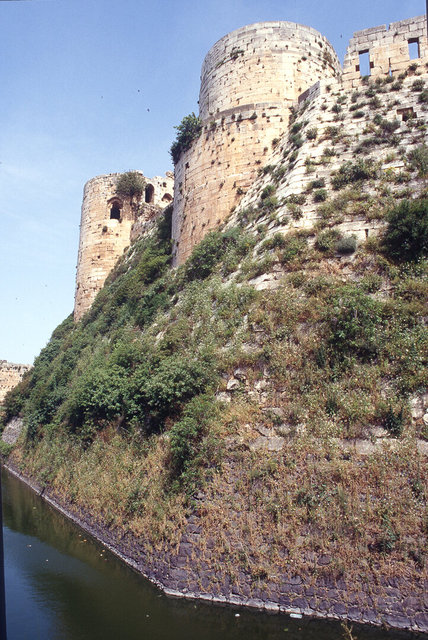
The inner ward defended by a moat and steep glacis. A much diminished garrison surrendered to Baibars, the Mamluk Sultan of Egypt in 1271 marking the beginning of the end of Crusader occupations in the Levant.
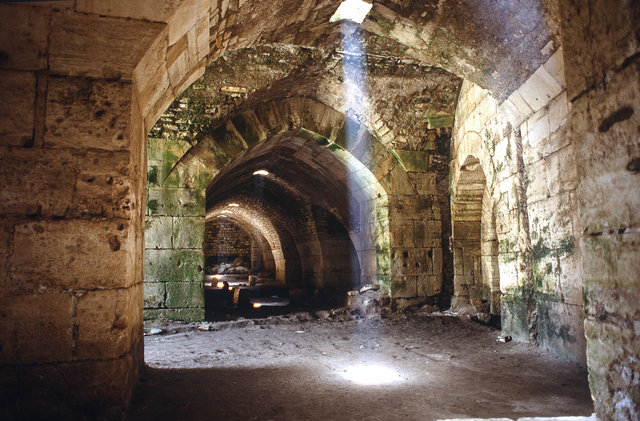
These garrison corridors were tall enough that mounted soldiers could pass through. The last Crusaders were finally driven from the Holy Land in 1291.
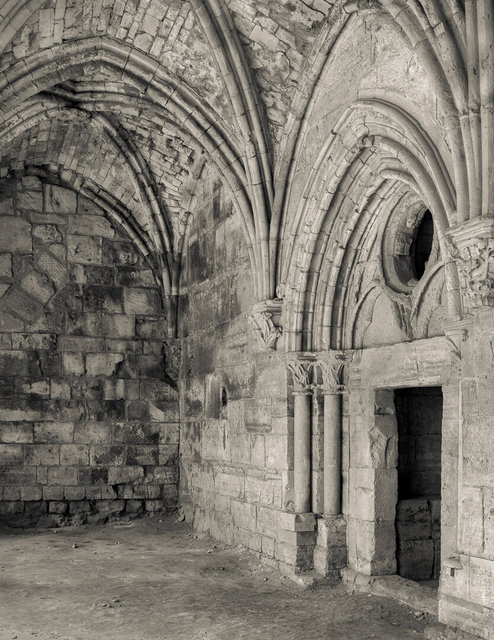
The gallery of the Knights Hall inside the fortress is late 13th C. work. the Franks brought a new design vocabulary from Europe into the Byzantine and Muslim east. The gothic tracery of this hall was recently damaged in a government airstrike.
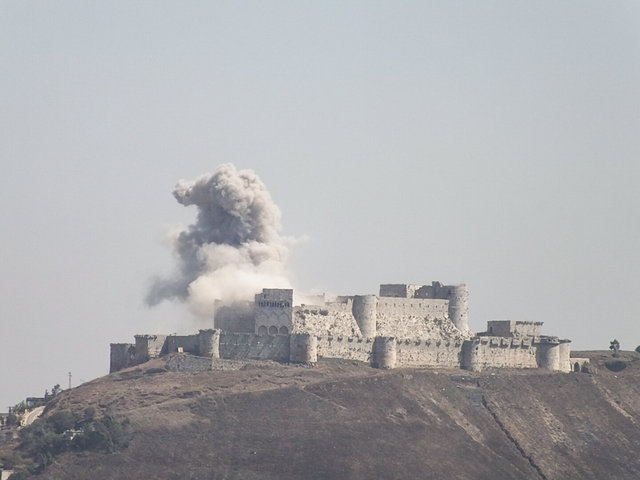
Syrian government airstrike on Krak des Chevalier in its struggle to retake the fortress from rebels in March 2014. (Image courtesy Architexturez Newsletters.)
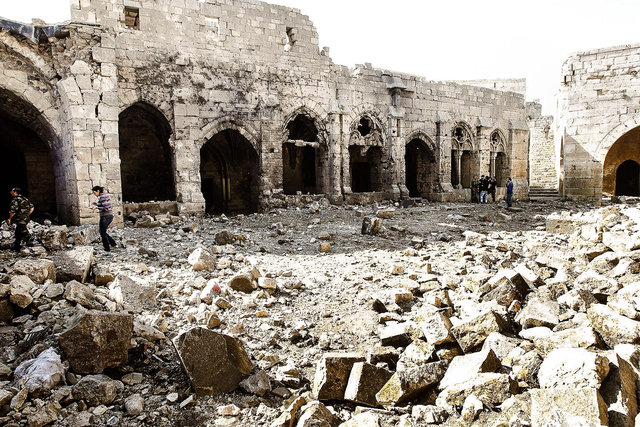
Damage to the Gallery of Knights from government shelling. (Credit: Str/EPA/Shutterstock.)
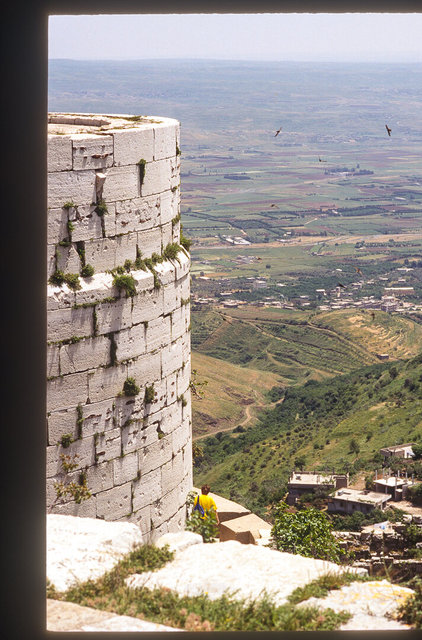
The view from the inner ward of the countryside below. During the Syrian civil war the castle was held by rebels from 2011 to 2014. It was shelled and bombed in 2013 by government forces. A Latin inscription over a lintel reads "Grace, wisdom, and beauty you may enjoy, but beware pride which alone can tarnish all the rest."